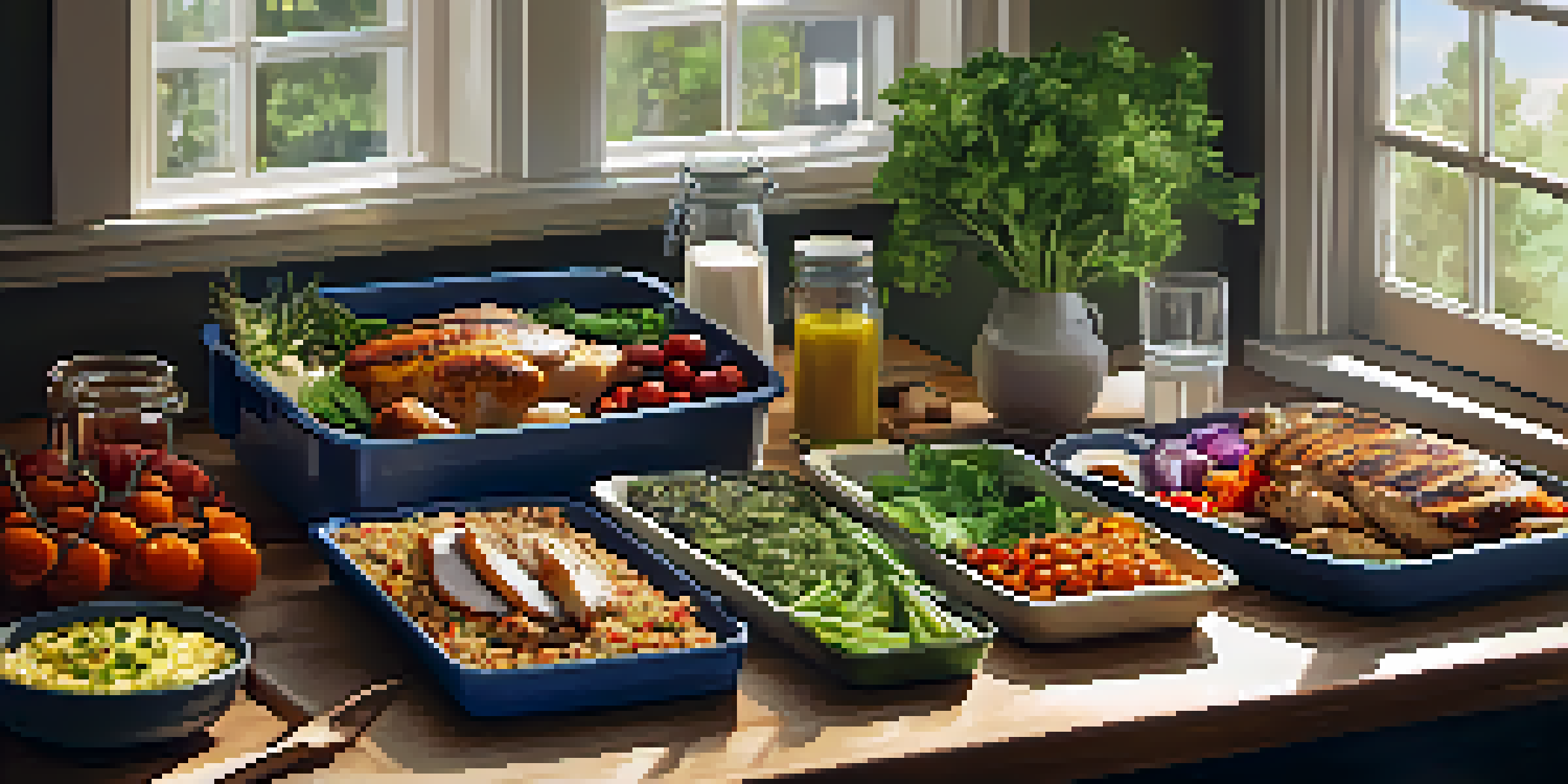Implementing a Caloric Surplus: Strategies for Gaining Muscle

Understanding Caloric Surplus: The Basics of Muscle Gain
A caloric surplus simply means consuming more calories than your body burns. This extra energy is essential for muscle growth, as your body needs fuel to repair and build muscle fibers after a workout. Think of it as giving your body the building blocks it needs to create new muscle, similar to how a construction crew requires materials to build a house.
You are what you eat, so don't be fast, cheap, easy, or fake.
When you’re trying to gain muscle, it’s crucial to ensure that the surplus is adequate but not excessive. An appropriate surplus can help in achieving your muscle gain goals without leading to unwanted fat gain. Typically, a surplus of 250 to 500 calories per day is recommended for most individuals looking to bulk up effectively.
Finally, remember that not all calories are created equal. Focusing on nutrient-dense foods will not only help you meet your caloric goals but will also provide the essential vitamins and minerals your body needs to function at its best. It’s about quality as much as quantity!
Setting Your Caloric Goals: How to Calculate Your Needs
Before diving into a caloric surplus, it’s important to know your maintenance calories—the number of calories your body needs to maintain its current weight. You can estimate this using various online calculators that take into account factors like age, weight, height, and activity level. This initial step is crucial, as it sets the foundation for your muscle-gaining strategy.

Once you have your maintenance calories, you can easily determine your caloric surplus. For example, if your maintenance is 2,500 calories, consuming between 2,750 and 3,000 calories daily would be a great starting point. It’s like having a roadmap; knowing where you are helps you navigate toward your destination more effectively.
Caloric Surplus is Key to Muscle Gain
Consuming more calories than your body burns is essential for muscle growth and repair after workouts.
It’s also wise to track your progress regularly. Adjust your caloric intake based on how your body responds over time. If you’re not gaining weight, you may need to increase your intake further, while consistent weight gain could indicate it’s time to evaluate your strategy.
Prioritizing Protein: Fueling Muscle Growth
Protein is a vital macronutrient when it comes to building muscle. To optimize muscle gain, aim for around 1.6 to 2.2 grams of protein per kilogram of body weight each day. This might sound daunting, but incorporating protein-rich foods into your meals can make it easier than it seems.
Success is the sum of small efforts, repeated day in and day out.
For example, consider snacks like Greek yogurt, cottage cheese, or a protein shake after your workout. These options not only help you meet your protein goals but also provide convenience, making it easier to stay consistent. It’s like having a secret weapon in your nutrition arsenal!
In addition to quantity, the timing of your protein intake matters too. Consuming protein-rich meals or snacks spaced throughout the day can help maximize muscle protein synthesis. Think of it as refueling a car at regular intervals to keep it running smoothly; your body works in a similar way.
Choosing the Right Foods: Nutrient-Dense Choices
When implementing a caloric surplus, the foods you choose matter significantly. Opt for nutrient-dense foods that provide essential vitamins and minerals, as well as calories. Whole grains, lean meats, nuts, seeds, fruits, and vegetables should all find a place in your diet, ensuring you’re not just piling on empty calories.
Imagine your body as a high-performance vehicle; it runs best when filled with premium fuel. Foods rich in nutrients will help not only with muscle gain but also improve your overall health and performance. It’s about fueling your body properly to get the best results.
Protein Intake Supports Muscle Growth
Aiming for 1.6 to 2.2 grams of protein per kilogram of body weight daily is crucial for optimizing muscle gain.
Additionally, don’t shy away from healthy fats, as they are calorie-dense and can help you reach your caloric goals more easily. Foods like avocados, olive oil, and fatty fish are excellent choices that can enhance your meals while supporting your muscle-building efforts.
Meal Prep and Planning: Staying on Track
Meal prepping can be a game-changer when trying to implement a caloric surplus. By planning your meals in advance, you can ensure that you have the right foods on hand, making it less likely for you to stray from your goals. Think of it as setting yourself up for success by removing any potential obstacles.
Start by dedicating a few hours each week to cook and portion out meals. This could include batch-cooking items like quinoa, grilled chicken, or roasted vegetables. Having these ready-to-eat meals available will save you time and help you avoid the temptation of quick, unhealthy options.
Moreover, consider keeping healthy snacks readily available as well. Nuts, protein bars, or homemade energy balls can be great for on-the-go nourishment. The more prepared you are, the easier it will be to maintain your caloric surplus and stay on track with your muscle-gaining goals.
Hydration: An Often-Overlooked Component
While focusing on a caloric surplus, don’t forget about the importance of hydration. Water plays a crucial role in overall health and muscle recovery but is often overlooked. Staying well-hydrated helps your body efficiently transport nutrients and aids in digestion, which is vital when consuming more food.
Aim for at least 2-3 liters of water a day, adjusting based on your activity level and climate. Think of water as the oil in a machine; it keeps everything running smoothly, ensuring that your body can function optimally as you work toward your muscle-building goals.
Meal Prep Helps Maintain Goals
Planning and preparing meals in advance can significantly aid in adhering to a caloric surplus and muscle-building strategy.
Additionally, consider incorporating electrolyte-rich beverages, especially after intense workouts. This can help replenish lost nutrients and keep you feeling your best, ready to tackle your next training session with vigor.
Monitoring Progress: Adjusting Your Strategy
As you embark on your journey of implementing a caloric surplus, it’s essential to monitor your progress regularly. Keep track of your weight, strength gains, and how you feel overall. This will help you determine whether your strategy is effective or if adjustments are necessary.
Consider taking body measurements or progress photos to visually track changes over time. This can be a motivating factor, as seeing physical changes can boost your morale and commitment to your goals. It’s like checking your map along the journey to ensure you’re headed in the right direction.

If you find that you’re gaining weight too quickly or not at all, don’t hesitate to adjust your caloric intake or macronutrient ratios. Flexibility is key in any nutrition plan, allowing you to tailor your approach based on your unique needs and responses.